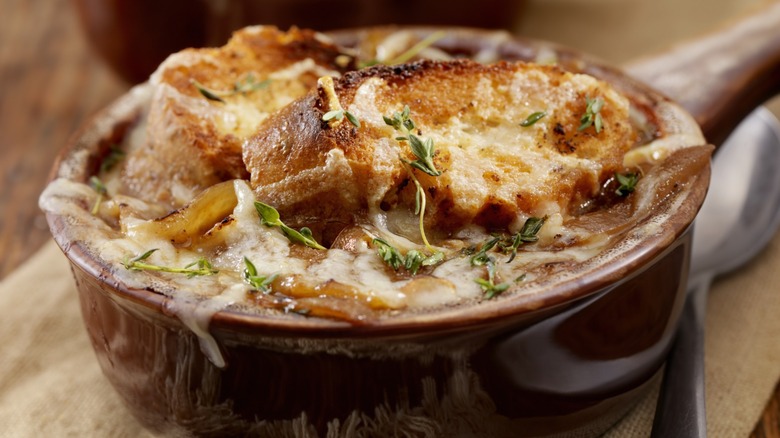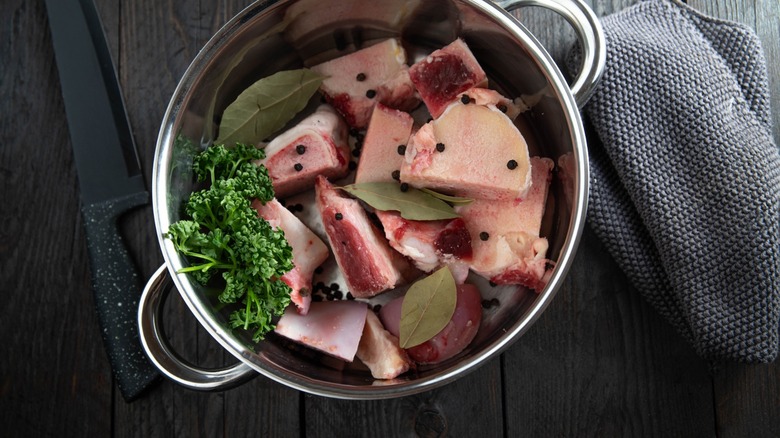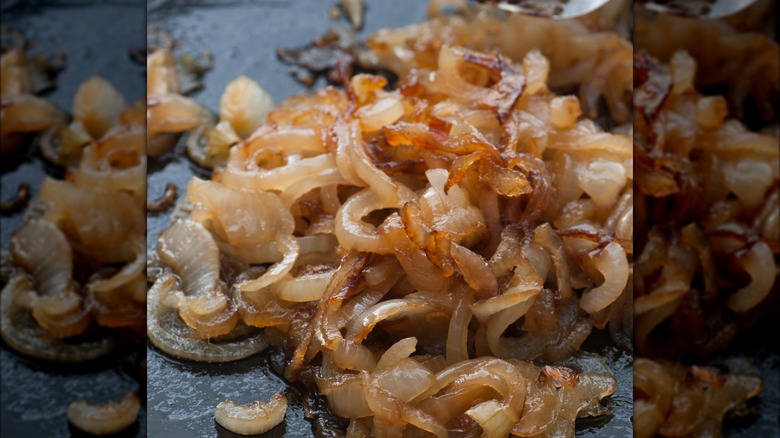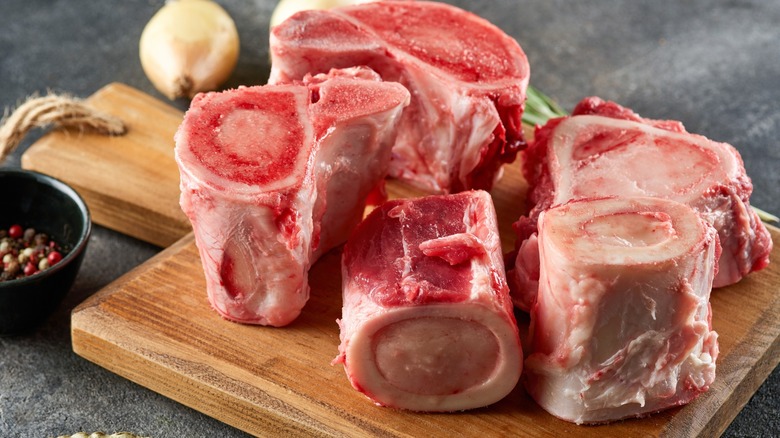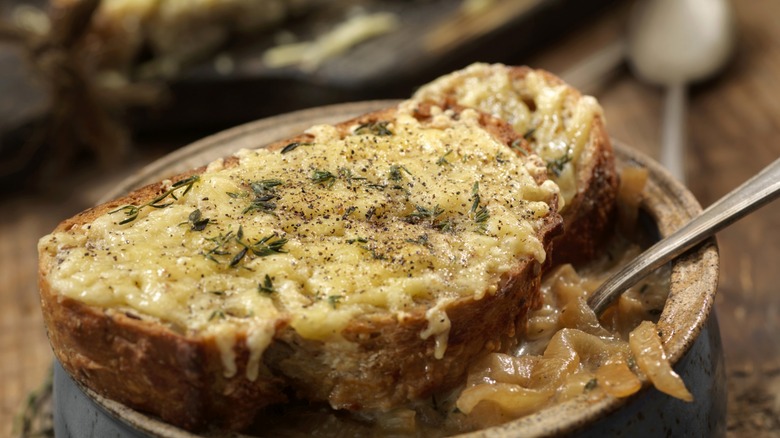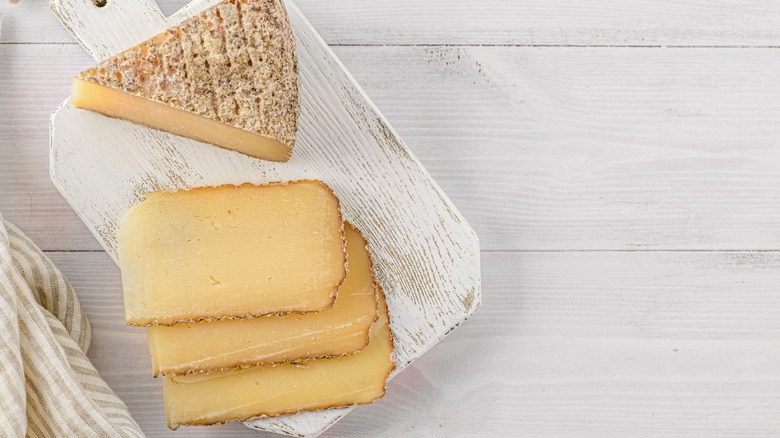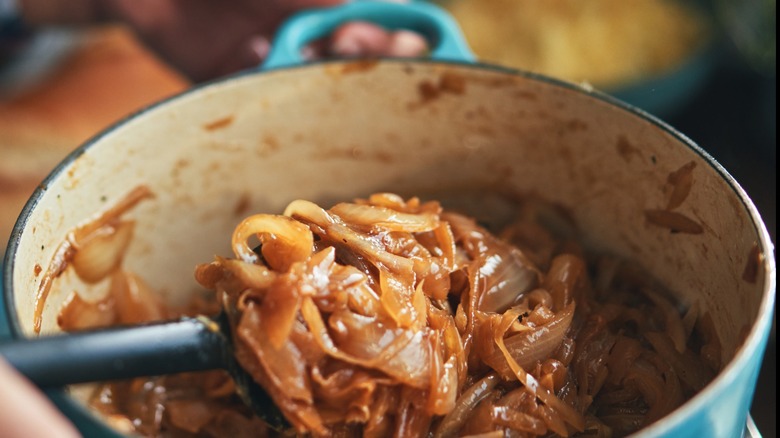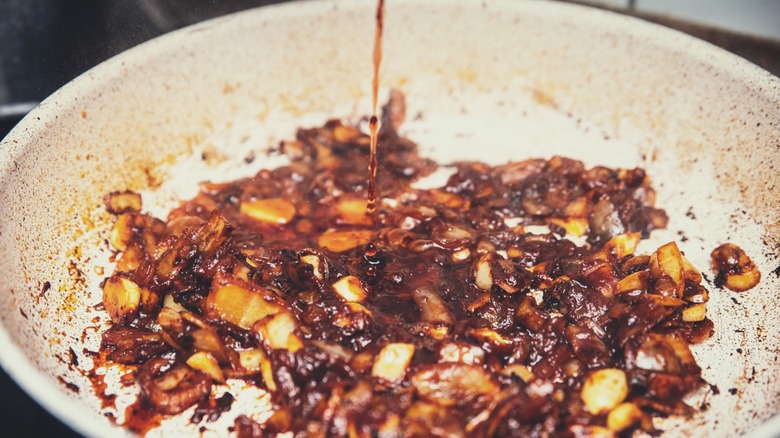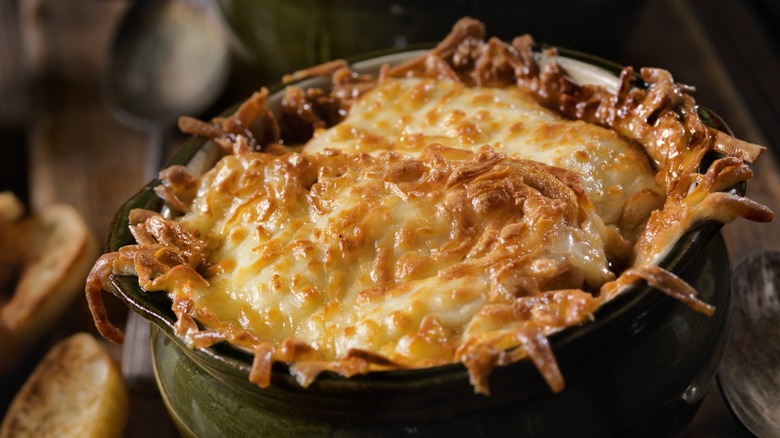9 Mistakes Everyone Makes When Cooking French Onion Soup
Is there anything more comforting and soul-soothing in the world than French onion soup? A hearty bowl topped with a thick slice of toasted baguette smothered in gooey melted cheese is one of life's greatest pleasures. The hot, sweet, salty, cheesy soup is especially ideal if you're sick or have had a particularly tough week.
French onion soup may seem like a simple dish to make, and it's true that once you get down to cooking it, it's not that complicated. But, as with all simple recipes, it can be deceptively hard. With so few ingredients, you need to ensure you're getting every step right. How do you avoid making these gaffes? By reading up on the process — and we're here to help with that. From rushing through caramelization to using the wrong pan, we've taking a look at the nine mistakes everyone makes when cooking French onion soup. We know you're guilty of at least one of them, and so are we!
1. Rushing it
We're not sure who it was that coined the phrase "Good things take time," but they were definitely right. French onion soup is a good thing, and it absolutely isn't a five-minutes-and-done recipe. Making authentic French onion soup from scratch is a labor of love.
In fact, from making the stock from scratch to caramelizing the onions, it can take up to 24 hours to perfect French onion soup. Even if you're using ready-made stock, ensuring your onions are perfectly cooked can be a seriously slow process, taking an hour or more. Since they're the key ingredient that gives the soup its sweet, rich flavor, it's a step you definitely want to take your time with. Then, the flavors of the onions and broth need time to properly meld. Making this soup is a classic lazy weekend afternoon cooking event, requiring the chef to stand over a bubbling pot and let the dish develop for long periods of time. Whether you love or hate this, one fact is certain: Your house will smell amazing.
2. Not caramelizing the onions properly
Onions are indisputably the star of the show here (and in our opinion, it's about time they got their place in the limelight). There aren't many other ingredients in French onion soup, so you need to take your time to ensure you're getting the best possible flavor out of them. One of the main mistakes people make in this department is not caramelizing the onions properly.
Set your pan over a low heat and use a combination of butter and olive oil for the best results, to prevent burning. Slice your onions thinly, then pop them in the pan and allow them to slowly caramelize. This will take at least 45 minutes. Yes, they may look like they're burning, but as long as the heat is low, they'll be fine. What you want is a deep, rich, dark brown color. It should look a bit like Marmite. They should taste sweet, sticky, and unctuous. If you end up making too many onions, you can always save them – caramelized onions are great in a grilled cheese!
3. Using the wrong stock
Only one type of stock is used in authentic French onion soup. The dish is always made with beef stock, and in France, it's always homemade. If you prefer, you can use chicken stock, but it'll be a lighter concoction. If you're cooking for vegetarians or vegans, you can swap it out for veggie stock, with an added splash of vegetarian Worcestershire sauce and red wine to create complexity.
Homemade stock is always best, though, and some people believe store-bought beef stock isn't great quality. If you have to go with ready-made beef stock, buy the best quality you can. Some say store-bought chicken stock is better than ready-made beef stock; consider sampling a few options so you can decide for yourself.
But seriously: Consider making your own beef stock for this dish. Yes, it takes time and if you don't have a batch in your freezer ready to defrost, you'll probably want to make it the day before you plan to prepare your soup. You'll also need to visit your local butcher to get bones for boiling. Trust us, though — the flavor is worth it.
4. Forgetting the bread
Repeat after us: The crouton is a must! No bowl of French onion soup is complete without a crusty slice of baguette, topped with oozing, melted Gruyere cheese. This is no mere garnish — it's an essential building block of the dish.
The bread should be from a baguette, but if you have something similar at hand, like ciabatta or even some crusty white farmhouse loaf, that'll do. Some people use multiple chunks of bread, or even make specialized croutons. This is less traditional, but acceptable. As for the cheese, it really should be Gruyere. Said cheese needs to be grated liberally over the bread and soup and melted under the broiler or grill until the top goes slightly crispy. All in all, this makes for one of the most delicious parts of French onion soup. It elevates the dish from humble meal into something decadently delicious.
5. Using the wrong cheese
Ask any French person what cheese goes on the crouton in French onion soup and they'll tell you Gruyere. It really has to be this sharp, smoky cheese. If you absolutely can't find it, a sharp cheddar, American Swiss cheese, Norwegian Jarlsberg, Dutch Gouda, and Edam are decent substitutes. If none of these are an option, keep in mind that whatever cheese you use needs to be salty, smoky, and rich, to complement the sweet caramelized onions. Also, it needs to melt well.
Grate the cheese on top of the slice of crusty baguette. It needs to be fairy pulverized, to ensure even texture. Don't, and we repeat, don't decide to skip the cheese — it's what takes French onion soup to the next level. If you're preparing the soup for a vegan crowd, though, you don't need to despair — simply swap Gruyere for your favorite plant-based grated cheese.
6. Trying to make it healthy
French onion soup boasts rich, beefy, salty stock, sweet and sticky caramelized onions, a crisp baguette that shatters under your spoon, and unctuous melted cheese. It's delicious — and it's not designed to be the healthiest soup around. Trying to make it so is a major mistake.
The fact is, this soup isn't designed for enjoying every day of the week. It's a treat — the sort of comfort food you spoil yourself with, especially when you need to brighten up a grey day or lift your spirits after a tough week. Don't try to transform it into something else by using low-fat cheese or reduced-salt stock, unless you have a health condition that requires this sort of adjustment and you absolutely must have your fix of French onion soup. This soup is guaranteed to be a cozy bowl of deliciousness, provided you stick to a classic recipe. If you don't, it loses all its lovely flavors and contrasts, and typically ends up being a disappointing bowl of tasteless onion shreds. Leave the recipe as-is; whether you enjoy yours under a blanket on the couch, with your better half after a busy day at the office, or around a table with friends is up to you.
7. Not using the right pot
You can make soup in whatever pot you have at hand, right? Yes, you technically can — but using the right pot will ensure your soup turns out perfect. So, what sort of pot is the right pot for French onion soup? Definitely not tall, narrow pots; they aren't great for caramelizing onions, as the chopped veggies become crowded in the pan and start to steam, rather than turning sweet and sticky. A Dutch oven with a heavy base is ideal, as it allows you more control over the browning onions. A deep sauté pan, or any pan that's wider than it is deep, also works. This allows the onions room to spread out, release their sugars, and caramelize.
A shallow, wide pan also helps the beef broth reduce, concentrating all that rich, meaty flavor. You don't need to use a stove-to-table pan either, as you'll be dishing the soup up in bowls. The cheese-crowned bread that tops each bowl needs to be popped under the broiler or grill before serving. Using a baking sheet for this process works well, or oven-safe bowls.
8. Omitting the booze
Booze is an essential ingredient in traditional French onion soup. While many recipes stick with sherry, there are plenty of cooks out there who swear by the sweet warmth of brandy. Others prefer white or red wine. Use whatever you like, but do add a splash of something.
Not only is adding alcohol a great way to deglaze the pan after caramelizing all those onions, it also adds a rich hit of complex flavor and umami to your soup, making it even tastier. If you're using white wine, opt for a dry wine like Sauvignon Blanc or Chardonnay. Furthermore, don't forget to add the alcohol once the onions have finished caramelizing. Adding it too soon will prevent your onions from becoming dark, sweet, and sticky. Once you've reached that point, add a splash to the pan, crank up the heat, scrape up all the delicious bits from the bottom of the pan, and allow the alcohol to burn off for a minute or two. Then add your stock and other ingredients.
9. Using the wrong serving bowls
While you can serve your French onion soup however you want, the specific way the French serve this dish ensures it's out of this world. The key is to use small, oven-proof bowls. This makes it easy to add the sliced baguette garnish: You simply pop the bowls under the broiler or grill until the cheese melts all over the bread and into the soup itself, remove them from the heat source, and serve them piping hot. We're not drooling, you're drooling.
For oven-safe dishes, look for those made of stoneware, porcelain, or tempered glass – never put regular glass bowls in the oven. All these materials are safe for both the oven and microwave. If you shop around, you might even find soup bowls with handles on the sides. Just be careful when dishing it up, and don't forget to remind diners that their bowl is hot. You also want a bowl that's pretty deep, so there's room for the soup and cheese-covered bread. Skimping on soup so you can fit the crouton would be a tragedy.
